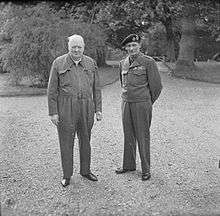Siren suit
The siren suit is a one-piece garment for the whole body which can easily be put on or taken off, originally designed for use on the way to, and in, air-raid shelters.[1] The suit solved the problems of warmth and modesty encountered when seeking shelter during nighttime air raids in the United Kingdom during World War II. It was roomy and could be put on over night clothes quickly when an imminent air raid was announced by the sirens.
The suit was worn by both children and adults when sheltering in either back garden or public shelters.[2][3]
History

Similar in style to boilersuits worn by many workers, including mechanics, bricklayers, and tank crews to protect their standard clothing, the siren suit was invented by Winston Churchill as an original leisure suit in the 1930s.[4] He played a large part in popularising it as an item of clothing during World War II, wearing it regularly, including when meeting other important people, such as U.S. President Franklin D. Roosevelt, General Dwight Eisenhower[5], and Soviet leader Joseph Stalin.[6]
The advantages of clothing that could be easily and quickly put on over other clothing led to the adoption of this style of suit during the war by many who were forced to leave their homes to seek shelter during air raids. Warning of the raids was given by sirens, so these suits came to be known as siren suits.
Wearing dresses or professional clothing while in an air raid shelter may not have been very practical.[7]
Construction
Siren suits were constructed in a loose-cut design, with zippered or button closures, an optional belt, and large simple pockets. The suits were made of many fabrics, most typically wool, cotton, or other materials available under clothing rationing. Suits could be bought ready-made[3][8] or could be hand-made with a pattern and available fabrics. Some suits had a panel at the back that opened to allow the wearer to use a toilet without removing the entire suit.[9]
In popular culture
Winston Churchill was a famous wearer, having a pin stripe version, which he wore during the war years and then for portraits by Oscar Nemon and Frank O. Salisbury in the 1950s.[10] Another suit, made of bottle-green velvet, was created for him by Turnbull & Asser.[11] Austin Reed also made him a suit.[12] In 2002, one of his grey pinstripe suits was sold for £29,875.[13]
These suits form a common motif in descriptions of war-time childhoods.[14][15][16]
Children's siren suits
Although early siren suits were fashionable, siren suits for children were more geared towards comfort for the children seeking shelter during an air raid rather than style. The children's suits were advertised as onesies "knitted with 10 ounces of 4-ply wool"; they were not marketed as being for protection during air raids like men's siren suits.[7] The suits featured a fur-lined hood to keep the child's head and ears warm as they sought shelter.[17]
Women's siren suits
In addition to being protective gear, siren suits for women were fashion statements and were marketed as such to avoid causing fear regarding the threat of raids. "Women are depicted as wearing highly fashionable siren suits but are not running to or hiding in an air raid shelter. The woman on the right even wears the hood over her hair and hangs her purse over her shoulder to complement the look of the siren suit".[7] Some women claimed wearing the siren suit "protected their modesty" in a comfortable way.[18]
References
- URL:http://oxforddictionaries.com/definition/english/siren-suit?q=siren+suit. Accessed: 2013-06-20. (Archived by WebCite® at https://www.webcitation.org/6HViXEs1y)
- "WW2 People's War - My Homemade 'Siren Suit'". BBC. 2004-06-12. Retrieved 2013-06-19.
- "Tatler Magazine, Summer 1940 | Battle of Britain Day by Day". Battleofbritainblog.com. Retrieved 2013-06-19.
- Quentin James Reynolds (1 November 1963). Winston Churchill. Random House. p. 173. Retrieved 12 March 2013.
- Time Inc (19 January 1942). LIFE. Time Inc. p. 23. ISSN 0024-3019. Retrieved 11 March 2013.
- "Prescott Evening Courier - Google News Archive Search".
- "The Siren Suit – ENG 410: WWII Literature". Retrieved 2019-12-02.
- Dominique Veillon (1 October 2002). Fashion Under the Occupation. Berg. pp. 9–. ISBN 978-1-85973-548-0. Retrieved 25 March 2013.
- "A History of the World – Object : Siren Suit". BBC. 1970-01-01. Retrieved 2013-06-19.
- Vanessa Thorpe and John Vincent (11 November 2002). "Churchill's Blitz siren suit put up for auction | UK news | The Observer". London: Guardian. Retrieved 2013-06-19.
- Leitch, Luke (2 September 2011). "Turnbull & Asser: The best of British - Telegraph". London: Fashion.telegraph.co.uk. Retrieved 2013-06-19.
- "Austin Reed - Royal Purveyor". Retrieved 2019-10-22.
- Bennett, Will (2002-12-13). "£30,000 for Churchill's suit". London: Telegraph. Retrieved 2013-06-19.
- Dick Lynas (9 June 2010). Pies Were for Thursdays. AuthorHouse. p. 9. ISBN 978-1-4670-0627-9. Retrieved 25 March 2013.
- Lesley Pearse (30 May 2011). Ellie. Random House. pp. 103–. ISBN 978-1-4464-7443-3. Retrieved 25 March 2013.
- Annie Groves (27 October 2011). Home for Christmas. HarperCollins UK. pp. 90–. ISBN 978-0-00-741939-5. Retrieved 25 March 2013.
- "BBC - WW2 People's War - Fond Memories of the Siren Suit by a Child in Penge". www.bbc.co.uk. Retrieved 2019-12-02.
- "All For Onesie: The Siren Suit". Off the Cuff: The Turnbull & Asser Blog. Retrieved 2019-12-02.
Further reading
- Siren Suit at "The History of the World"
- About the Siren Suit
- Jonathan Walford (1 April 2011). Forties Fashion: From Siren Suits to the New Look. Thames & Hudson. ISBN 978-0-500-28897-9.